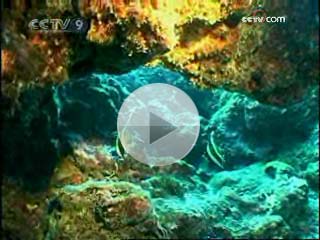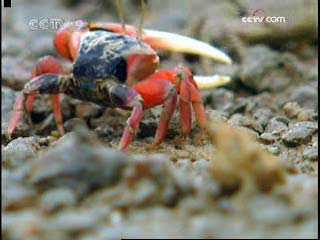------Program code: NS-080815-04449 (what's this?)
Source: CCTV.com
08-15-2008 10:49
The mudflat is in fact very dry. To preserve the water in their bodies, the mangroves must maintain an accurate number of leaves in their crowns. The excess leaves will wither away and become food for the grapsidae, along with the petals that fall to the ground in the rainstorm.
 |
However, there are just a few petals on the ground. Only the quickest of the crabs will enjoy this particular windfall.
The tide is receding again, carrying with it many fallen leaves and flowers.
 |
As soon as the tide has receded, the fiddler crabs become busy again. But they are not looking for food. Instead they are restoring their homes that were destroyed, as they are every day, by the tide.
Having repaired its cave, the male fiddler crab carefully cleans its pincers.
A female fiddler crab enters the scene. The male waves its pincers, as a way of showing off it strength. The female answers this mating call.
The male crab uses its pincers as a shield and sword against a rival. In ancient China, the fiddler crab was known as the “sword crab”.
The female crab is a practical creature, and she is particular about her bridal chamber. Before deciding on her bridegroom-to-be, she will check out more than a hundred caves recently built by the male crabs.
It’s getting late, but the aigrets are still out looking for food on the mudflat. It usually takes a month for the baby aigrets to learn to fly. Then they can leave the nest.
June is the month when the coconuts growing beside the mangrove forest, ripen.
In the village beneath the coconut trees, people are starting to train in their dragon boats. The dragon boat race is a traditional part of the Double Fifth celebrations.
The peaceful mangrove gulf is a perfect location for dragon boat training.
Silently, the mangrove forest is changing.
The ripe fruit remains attached to its mother. It will absorb nutrition until a seedling buds. This viviparous seedling, as it is known, is unique to the mangrove.
The viviparous seedling, even during its relatively short growth period, has already learned many skills. Its root section is larger than its leaf section. This unique structure is vital to its survival.
The aigrets flock to the rice field to search for food again. They are excellent field managers, in that they keep insect and pest levels very low. Pesticides are never used here.
The pond heron is fortifying its nest. However, there’s a problem with the branch it has found.
After a month, the baby aigret has grown up. But it still can’t fly.
The young aigrets, being much bigger, have developed a big appetite. Their parents have to head off looking for food for them every fifteen minutes.
It’s hard work bringing up babies, especially for aigrets, because they are big in size and have a corresponding appetite. Every 15 minutes a parent will arrive back at the nest bringing food.
Editor:Yang
